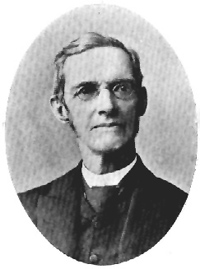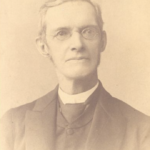John C. Lowrie
Reverend John Cameron Lowrie (December 16, 1808-June 7, 1900) was appointed in 1832 by the Western Foreign Mission Society to a mission in India. He arrived in Calcutta with his wife in 1833, before arriving in Lodinia in 1834. He returned to the United States in 1836 for health reasons. Rev. Lowrie’s travels are contextualized in the Historical Sketches of the India Missions with a number of other Presbyterian Missionaries who travelled with him and helped develop the mission in India. Despite Rev. Lowrie’s departure, the mission continued on without him and grew tremendously in scale over the 50 years that are described in the book.

Themes
“From the beginning of our missionary career, the public proclamation of the gospel, or preaching in the technical sense of the word, has ever been regarded as of prime importance.” (Historical Sketches of the India Missions, p. 21).
“Probably every missionary, when he sets out for foreign land, goes with large expectations of success; yet how few realize all that they looked for! Certainly this is the experience of at least some of the members of our mission. Where we looked for hundreds of converts, we have seen only tens…” (Historical Sketches of the India Missions, p. 91).
Rev. Lowrie and his team’s primary reason for traveling to India was for religious conversion. In their time there, the team worked on building religious institutions, like schools and orphanages, as a part of their project of religious conversion. Their aims of religious conversion also obviously coincide with colonial ideology, which is particularly interesting given the British colonization of India occurring between 1858 and 1947.
“In a country where English education is in great demand, a missionary finds a door open for usefulness even before he has a knowledge of the native languages. Accordingly, there are few, if any of our stations, where the missionaries, have not plunged at once into the work of education.” (Historical Sketches of the India Missions, p. 27)
“The number of orphans that have been educated in these two institutions cannot now be ascertained without difficulty. Almost all, if they had remained out, would have been brought up in Hindooism or Mahomedanism. As it was, they were educated in the faith of Christianity; and a goodly number have become Church members.” (Historical Sketches of the India Missions, p. 35-36)
While Rev. Lowrie and his team were in India, they engaged in building orphanages and schools as a subsidiary of their project of religious conversion. By building these institutions, they were able to spread religious doctrine to young Indian people in this more institutionalized context and to provide direct services that were more effective in creating converts. Integrating their religious teachings into the sociopolitical fabric of the regions they occupied was one of the team’s strategies for creating converts.
“It happened that a press Moonshee became very ill; and after being treated by the native doctors with no hope of recovery he asked me to do something for him. As the case seemed otherwise hopeless, I thought it my duty to do what I could; and by the good providence of God my treatment was successful. The news of this soon spread over the city… so that I soon found myself in the midst of a regular medical practice.” (Historical Sketches of the India Missions, p. 38)
Rev. Lowrie and the other missionaries had no formal medical training when they left for India, though they did bring some medical books with them. Because of one fluke-successful treatment, many Indian people began to turn to the missionaries for medical advice, which proved to be somewhat effective in convincing people of their religious beliefs. Because of the popularity of their medical treatments with the Indian people, the team did later invite some medical doctors to join the mission.
“When Mr. Wilson and I were first in Calcutta, on our way to Lodinia, we were advised to take with us a printing press. We accordingly bought an old-fashioned wooden press…” (Historical Sketches of the India Missions, p. 46)
Publishing and printing was one major way that Rev. Lowrie’s team shared religious doctrine with the Indian people. They brought a printing press with them to India, and used it to print a variety of religious information, like their sermons. They also learned to print in different languages, and were able to print diacritical marks. In the early days of their press, the team distributed books and printed matter for free, though they later began to sell their works for a small fee, which they noted reduced their demand. The team also began to later print some secular works, such as a weekly newspaper.
"From the beginning of our missionary career, the public proclamation of the gospel, or preaching in the technical sense of the word, has ever been regarded as of prime importance ." (Historical Sketches of the India Missions, p. 21)
Image: Rajput Court Artist, A Prince Hunting Boars with His Retinue, 19th Century
Primary Mission Stations
“Lodiana was not only nearer the center of the Sikh population than Umballa, but it was more populous; and the chief political and civil officers there were more friendly,- so friendly indeed that they offered Mr. Lowrie every inducement to make that place the starting point for his missionary work.” (Historical Sketches of the India Missions, p. 8).
“This, being in the North-West Provinces, is outside of the region chosen for our work by the founder of the Mission…Mr. Connelly… recommended that place as a station for some of the new missionaries, who were expected, and who were then on their way up the Ganges.” (Historical Sketches of the India Missions, p. 9-10)
“During the first summer after Mr. Lowrie’s arrival at Lodiana, he was obliged, under medical advice, to be in the hills. This gave him the opportunity of making the acquaintance of certain Christian people at Simla and Suthaboo.” (Historical Sketches of the India Missions, p. 10-11)
“In 1847 Jullunder was added to the number of our stations and the missionary who commenced the work there was Rev. Mr. Goloknath, with his wife” (Historical Sketches of the India Missions, p. 11)
“Umballa was occupied in 1849 by the Rev. J.M. Jamieson and his wife.” (Historical Sketches of the India Missions, p. 12)
“This valley has latterly become the seat of many Tea Factories, owned for the most part by Europeans.” (Historical Sketches of the India Missions, p. 14)
“The country around Pindee, is in some places broken and very irregular; and much of it is mountainous.” (Historical Sketches of the India Missions, p. 15)
“Hoshyarpore was occupied in 1867. It is the chief town, after Jullunder, in the country lying between the Sutlej and the Beeas.” (Historical Sketches of the India Missions, p. 17)
“Forezpore was taken up as a substation of Lahore, in 1870, and put in charge by the Rev. Esa Churrun.” (Historical Sketches of the India Missions, p. 17)
“While waiting in Calcutta, persons well acquainted with the state of the country, represented to Miss Davis, that the way was not then open for work among the women of North India…” (Historical Sketches of the India Missions, p. 107).
‘It was decided that Mr. Wilson should begin work at Farrukhabad, as the city was a large and important one, and the field unoccupied.” (Historical Sketches of the India Missions, p. 110)
“The principal station of this mission [the Kolhápur mission] is Kolhápur, a city of 45,000 inhabitants, situated 250 miles southeast of Bombay” (Historical Sketches of the India Missions, p. 152)
"Probably every missionary, when he sets out for foreign land, goes with large expectations of success; yet how few realize all that they looked for! Certainly this is the experience of at least some of the members of our mission. Where we looked for hundreds of converts, we have seen only tens..." (Historical Sketches of the India Missions, p. 91)
Image: Generation of Bagta, Fortified City of Ranthambhor, c. 1810-1818
